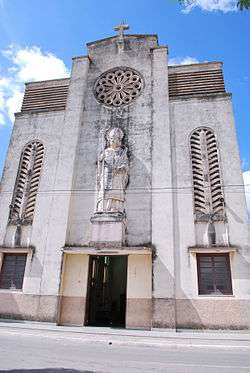Ciego de Ávila
Ciego de Ávila (Spanish pronunciation: [ˈsjeɣo ðe ˈaβila]) is a city in the central part of Cuba and the capital of Ciego de Ávila Province. The city has a population of about 119,000, in a municipality of 143,449.
Ciego de Ávila | |
|---|---|
A road in Ciego de Ávila | |
.png) Ciego de Ávila municipality (red) within Ciego de Ávila Province (yellow) and Cuba | |
| Coordinates: 21°50′53″N 78°45′47″W | |
| Country | Cuba |
| Province | Ciego de Ávila |
| Established | 1840[1] |
| Area | |
| • Municipality | 445 km2 (172 sq mi) |
| Elevation | 55 m (180 ft) |
| Population (2010)[3] | |
| • Municipality | 143,449 |
| • Density | 320/km2 (830/sq mi) |
| • Urban | 125,609 |
| Demonym(s) | Avileño/a |
| Time zone | UTC-5 (EST) |
| Postal code | 65200 |
| Area code(s) | +53 43 |
| Highways | Carretera Central |
Geography
Ciego de Ávila lies on the Carretera Central highway and on a major railroad. Its port, Júcaro, lies 24 km (15 mi) south-southwest on the coast of the Gulf of Ana Maria of the Caribbean Sea, in the adjacent municipality of Venezuela. The city is located about 460 km (290 mi) east of Havana and 110 km (68 mi) west of the city of Camagüey. It was part of the Camagüey Province until 1976, when Fidel Castro's government made Ciego de Ávila the capital of the newly created Ciego de Ávila Province.
By 1945, the municipality was divided into the barrios of Angel Castillo, Ceballos, Guanales, Jagüeyal, Jicotea, José Miguel Gómez, Júcaro, La Ceiba, Majagua, Norte, San Nicolás and Sur. After the new political and administrative division of Cuba in 1976, it was divided into four municipalities (Majagua, Ciego de Ávila, Baragua, and Venezuela).[1]
Climate
Ciego de Ávila experiences a tropical savanna climate (Köppen Aw).
| Climate data for Ciego de Ávila | |||||||||||||
|---|---|---|---|---|---|---|---|---|---|---|---|---|---|
| Month | Jan | Feb | Mar | Apr | May | Jun | Jul | Aug | Sep | Oct | Nov | Dec | Year |
| Average high °F (°C) | 81.1 (27.3) |
82.6 (28.1) |
85.8 (29.9) |
88.3 (31.3) |
89.4 (31.9) |
89.8 (32.1) |
91.6 (33.1) |
91.9 (33.3) |
90.5 (32.5) |
87.8 (31.0) |
85.8 (29.9) |
82.2 (27.9) |
87.2 (30.7) |
| Average low °F (°C) | 63.0 (17.2) |
62.8 (17.1) |
65.8 (18.8) |
68.0 (20.0) |
70.7 (21.5) |
73.0 (22.8) |
73.9 (23.3) |
73.9 (23.3) |
72.7 (22.6) |
71.2 (21.8) |
68.7 (20.4) |
64.4 (18.0) |
69.0 (20.6) |
| Average precipitation inches (mm) | 1.2 (31) |
1.1 (28) |
1.6 (41) |
3.2 (82) |
7.1 (181) |
7.5 (191) |
5.3 (135) |
5.6 (142) |
7.4 (187) |
7.0 (177) |
2.6 (66) |
1.2 (30) |
50.8 (1,291) |
| Source: CLIMATE-DATA.ORG[4] | |||||||||||||
History

The city of Ciego de Ávila was founded by 1840, having at the time 263 inhabitants. In 1877, its municipal government was created and the city became independent of the city of Morón. Ciego de Ávila gained importance when the Spanish army built a fortified military line, known as Trocha de Júcaro a Morón, to impede the pass of insurrectionist forces to the western part of the island during the 1st War of Independence (1868–1878). This "trocha", which made this region famous, was thought to be strong enough to stop the Cuban forces, but was not able to stop the pass of General Máximo Gómez and several hundred men. Many of the old Spanish colonial buildings in Ciego de Ávila (such as the Teatro Principal) were commissioned under Angela Hernández, viuda de Jiménez, a rich socialite who battled to create a cultural mecca in her hometown.
Demographics
In 2004, the municipality of Ciego de Ávila had a population of 135,736.[3] With a total area of 445 km2 (172 sq mi),[2] it has a population density of 305.0/km2 (790/sq mi).
Attractions
- Parque Martí is the largest park in the city of Ciego de Ávila.
- Teatro Principal is a 500-seat theatre located just a few blocks from Parque Martí.
- University of Ciego de Ávila (Universidad de Ciego de Ávila, UNICA) is the province's secondary education institution.
- IPVCE Ignacio Agramonte Instituto Pre-Universitario Vocacional de Ciencias Exactas (10 a 12 grado) con emphasis en las ciencias basicas: Fisica, Quimica, Matematica, Biologia y Electronica. Se encuentra en la carretera a Ceballos.
- la Turbina is a small amusement park located to the north west of the city with approximately 6 rides to use.
Media
Its present radio station, Radio Surco (previously Radio Cuba) was founded October 10, 1952.
Sports
Ciego de Ávila's basketball team has been one of the most successful teams in the country as it won 9 national championships since 2005.
Notable residents
- Andy Morales (b. 1974, Major League Baseball player
- Tony Pérez (b. 1942), Major League Baseball player
- Rusney Castillo (b. 1987), Major League Baseball player
- William Granda (b. 1985), member of Cuba's national basketball team
References
- Guije.com. "Ciego de Ávila" (in Spanish). Retrieved 2007-10-06.
- Statoids (July 2003). "Municipios of Cuba". Retrieved 2007-10-06.
- Atenas.cu (2004). "2004 Population trends, by Province and Municipality" (in Spanish). Archived from the original on 2006-07-14. Retrieved 2007-10-06.
- Info at en.climate-data.org